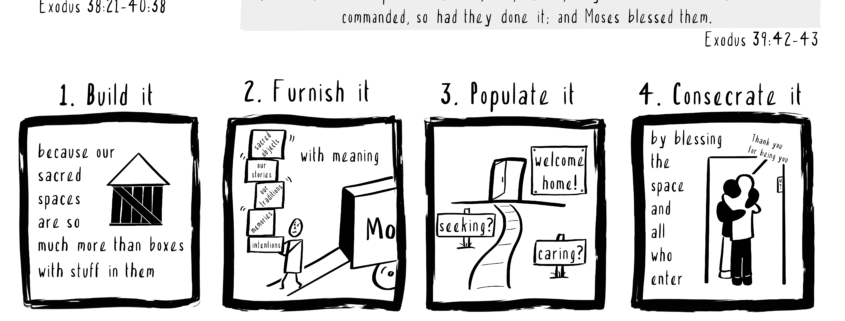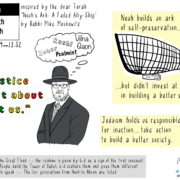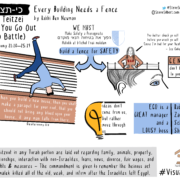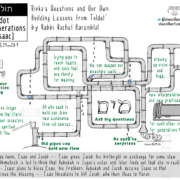Creating a Spiritual Home

Part of a yearlong Torah series about building and builders in Jewish spiritual life.
“A house is just a box where you keep your stuff.” A contractor tossed this comment over his shoulder as he left my new home, clearly thinking that he was dropping a pearl of wisdom.
I looked around. He had come to hang a painting over my bed that is too heavy for me to lift. It’s by an artist who was friends with my family. I’ve long admired her work, and until just a few years ago, the painting hung in my parents’ family room. My mother gifted it to me when she sold the house, after my father’s death.
I slowly turned, looking in all directions as I considered the “stuff” in my home. Art work, furnishings, books. Nearly everything tells me a story; about myself, about people I love, about places I’ve been and years gone by.
And I thought, “He’s wrong.” My house is so much more than a box filled with stuff. It was indeed simply an empty shell when the construction crew left, but now it is a home filled with meaning, not only because of the things in it, but because of my relationship with those things – because of the memories and happiness they ignite within me.
So too our houses of prayer. They are more than simply buildings. They are not important because they exist, but because of how they are used. They are places of worship, places that ignite memories, that link us to our tradition and our ancestors, that provide us with a communal space in which we can be in relationship, with each other and with the Divine.
And so too the Mishkan, the tabernacle that the Children of Israel built in the desert, following God’s detailed instructions. It provided a sacred space where the people could reach out to their God.
 In this week’s Torah portion (Pekudei), the last in the Book of Exodus, the people complete the task of building and outfitting the Mishkan. The passage in Exodus 39:42-43 echoes the passage in Genesis 2:1-3 when God finished creating the heavens and earth: both use the same verbs, both end with a blessing. God blessed the Sabbath, Moses blessed the people.
In this week’s Torah portion (Pekudei), the last in the Book of Exodus, the people complete the task of building and outfitting the Mishkan. The passage in Exodus 39:42-43 echoes the passage in Genesis 2:1-3 when God finished creating the heavens and earth: both use the same verbs, both end with a blessing. God blessed the Sabbath, Moses blessed the people.
 What I find most fascinating about both creation stories is that neither ends with the basic construction project. God doesn’t stop after creating the world; God “furnishes” the world with plants, animals, and finally humans. Moses and the people furnish the Mishkan with the altar and everything the priests need to perform their sacred duties.
What I find most fascinating about both creation stories is that neither ends with the basic construction project. God doesn’t stop after creating the world; God “furnishes” the world with plants, animals, and finally humans. Moses and the people furnish the Mishkan with the altar and everything the priests need to perform their sacred duties.
No building is complete when the construction crew leaves. An empty synagogue is no different than an empty office building or an empty store. The task is not done until the requisite materials are brought in – desks for the offices, cash registers for the stores, ritual items for the synagogues.
 And still, the buildings are incomplete. Fully outfitted with every “thing” necessary, they are nothing without us. No work is accomplished in an empty office, no goods sold in an empty store, no spiritual connections made in an empty prayer space.
And still, the buildings are incomplete. Fully outfitted with every “thing” necessary, they are nothing without us. No work is accomplished in an empty office, no goods sold in an empty store, no spiritual connections made in an empty prayer space.
My congregation rents the space in which we meet. Other groups use it for other purposes when we’re not holding services. And when no one is there, it is simply a large, empty room, with two concrete walls and two glass walls that look out onto a park. The view is lovely. But the room itself is an empty box; no personality, nothing to recommend it.
But it’s not hard to turn an everyday room into a sacred space. Bring out chairs and place them in a welcoming semi-circle. Set up the portable ark, take the Torah out of its protective case, take out the candle sticks and Shabbat candles, place the challah on its tray under the embroidered cover, and put out the prayer books.
 Then open the doors and welcome in the people who have come to pray in community. And in that moment, an everyday room is transformed into a sacred space, a meaningful spiritual home that is no different from any other synagogue, anywhere in the world. Because an impermanent spiritual home can become a holy space by virtue of the memories, intentions, and actions of the people who inhabit it, even if only for a few hours.
Then open the doors and welcome in the people who have come to pray in community. And in that moment, an everyday room is transformed into a sacred space, a meaningful spiritual home that is no different from any other synagogue, anywhere in the world. Because an impermanent spiritual home can become a holy space by virtue of the memories, intentions, and actions of the people who inhabit it, even if only for a few hours.
Like the things in my home, the ritual items in our synagogue have deeper meanings beyond their mere functions. The pointer we use when reading from the Torah scroll, called a yad, was donated by a long-time member who died last year just before his 100th birthday. Every time I take it in my hands, I think of him. The scroll itself was donated by a Pittsburgh synagogue that was closing its doors and seeking new homes for its ritual items. The stand on which the Torah rests inside the ark was handcrafted by one of our founding members.
A building is just a box until it becomes something else. The transformation from structure to sacred space takes a two-step process – furnishing it with meaningful “stuff,” and populating it with people who care about each other and who seek meaningful interactions with each other, with the ritual items they use together, and with their God.
Remember the blessings that God and Moses gave after they finished their creations? The next time you walk into the sacred place where you pray, take a moment to bless the people around you. Because like God and Moses, together you have created something remarkable.


By Rabbi Jennifer Singer. Sketch note by Steve Silbert.









